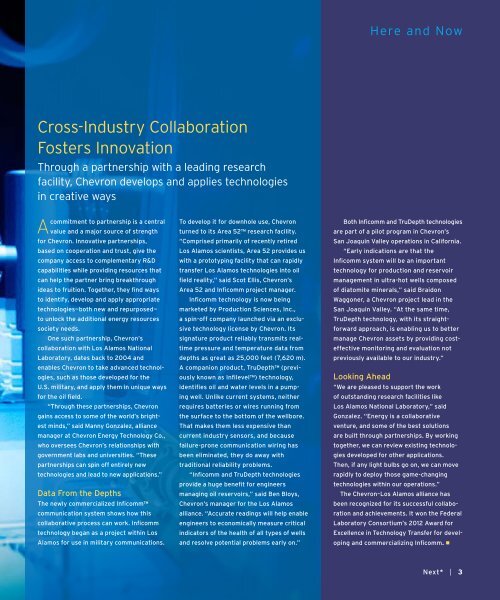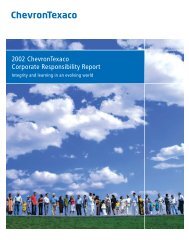Next* Magazine, Issue 5 - Chevron
Next* Magazine, Issue 5 - Chevron
Next* Magazine, Issue 5 - Chevron
You also want an ePaper? Increase the reach of your titles
YUMPU automatically turns print PDFs into web optimized ePapers that Google loves.
Cross-Industry Collaboration<br />
Fosters Innovation<br />
Through a partnership with a leading research<br />
facility, <strong>Chevron</strong> develops and applies technologies<br />
in creative ways<br />
Acommitment to partnership is a central<br />
value and a major source of strength<br />
for <strong>Chevron</strong>. Innovative partnerships,<br />
based on cooperation and trust, give the<br />
company access to complementary R&D<br />
capabilities while providing resources that<br />
can help the partner bring breakthrough<br />
ideas to fruition. Together, they find ways<br />
to identify, develop and apply appropriate<br />
technologies—both new and repurposed—<br />
to unlock the additional energy resources<br />
society needs.<br />
One such partnership, <strong>Chevron</strong>’s<br />
collaboration with Los Alamos National<br />
Laboratory, dates back to 2004 and<br />
enables <strong>Chevron</strong> to take advanced technologies,<br />
such as those developed for the<br />
U.S. military, and apply them in unique ways<br />
for the oil field.<br />
“Through these partnerships, <strong>Chevron</strong><br />
gains access to some of the world’s brightest<br />
minds,” said Manny Gonzalez, alliance<br />
manager at <strong>Chevron</strong> Energy Technology Co.,<br />
who oversees <strong>Chevron</strong>’s relationships with<br />
government labs and universities. “These<br />
partnerships can spin off entirely new<br />
technologies and lead to new applications.”<br />
Data From the Depths<br />
The newly commercialized Inficomm<br />
communication system shows how this<br />
collaborative process can work. Inficomm<br />
technology began as a project within Los<br />
Alamos for use in military communications.<br />
To develop it for downhole use, <strong>Chevron</strong><br />
turned to its Area 52 research facility.<br />
“Comprised primarily of recently retired<br />
Los Alamos scientists, Area 52 provides us<br />
with a prototyping facility that can rapidly<br />
transfer Los Alamos technologies into oil<br />
field reality,” said Scot Ellis, <strong>Chevron</strong>’s<br />
Area 52 and Inficomm project manager.<br />
Inficomm technology is now being<br />
marketed by Production Sciences, Inc.,<br />
a spin-off company launched via an exclusive<br />
technology license by <strong>Chevron</strong>. Its<br />
signature product reliably transmits realtime<br />
pressure and temperature data from<br />
depths as great as 25,000 feet (7,620 m).<br />
A companion product, TruDepth (previously<br />
known as Infilevel) technology,<br />
identifies oil and water levels in a pumping<br />
well. Unlike current systems, neither<br />
requires batteries or wires running from<br />
the surface to the bottom of the wellbore.<br />
That makes them less expensive than<br />
current industry sensors, and because<br />
failure-prone communication wiring has<br />
been eliminated, they do away with<br />
traditional reliability problems.<br />
“Inficomm and TruDepth technologies<br />
provide a huge benefit for engineers<br />
managing oil reservoirs,” said Ben Bloys,<br />
<strong>Chevron</strong>’s manager for the Los Alamos<br />
alliance. “Accurate readings will help enable<br />
engineers to economically measure critical<br />
indicators of the health of all types of wells<br />
and resolve potential problems early on.”<br />
Both Inficomm and TruDepth technologies<br />
are part of a pilot program in <strong>Chevron</strong>’s<br />
San Joaquin Valley operations in California.<br />
“Early indications are that the<br />
Inficomm system will be an important<br />
technology for production and reservoir<br />
management in ultra-hot wells composed<br />
of diatomite minerals,” said Braidon<br />
Waggoner, a <strong>Chevron</strong> project lead in the<br />
San Joaquin Valley. “At the same time,<br />
TruDepth technology, with its straightforward<br />
approach, is enabling us to better<br />
manage <strong>Chevron</strong> assets by providing costeffective<br />
monitoring and evaluation not<br />
previously available to our industry.”<br />
Looking Ahead<br />
Here and Now<br />
“We are pleased to support the work<br />
of outstanding research facilities like<br />
Los Alamos National Laboratory,” said<br />
Gonzalez. “Energy is a collaborative<br />
venture, and some of the best solutions<br />
are built through partnerships. By working<br />
together, we can review existing technologies<br />
developed for other applications.<br />
Then, if any light bulbs go on, we can move<br />
rapidly to deploy those game-changing<br />
technologies within our operations.”<br />
The <strong>Chevron</strong>–Los Alamos alliance has<br />
been recognized for its successful collaboration<br />
and achievements. It won the Federal<br />
Laboratory Consortium’s 2012 Award for<br />
Excellence in Technology Transfer for developing<br />
and commercializing Inficomm. ■<br />
<strong>Next*</strong> | 3

















